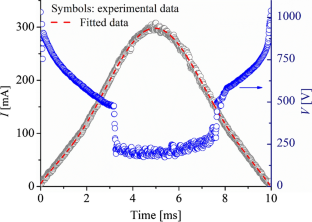Numerical Simulation of the Voltage–Current Characteristic of an Atmospheric Pressure Discharge: The Glow-to-Arc Transition
Abstract
The glow-to-arc transition of a convection-stabilized atmospheric pressure air discharge is numerically investigated. Two separate models are considered: a one-dimensional axisymmetric time-dependent fluid model of the positive column, describing the thermal-instability, and a sheath model of a cold cathode describing the field-emission instability, which must then be properly matched together. The fluid model considers the most important chemical reactions in air plasma, including thermal ionization in atomic collisions. The radial electric field in the plasma is obtained from the Poisson equation. The voltage–current characteristic of the discharge is simulated for a time-varying current up to 300 mA. It is found that at some critical value slightly above 200 mA, the contraction of the positive column arises from a vibrational–translational energy relaxation. The subsequent increases in the discharge current density in the positive column drive in turn a field-emission instability in the cathode, which is accompanied by a large voltage drop. Simulation results are validated against available experimental data.


 求助内容:
求助内容: 应助结果提醒方式:
应助结果提醒方式:


